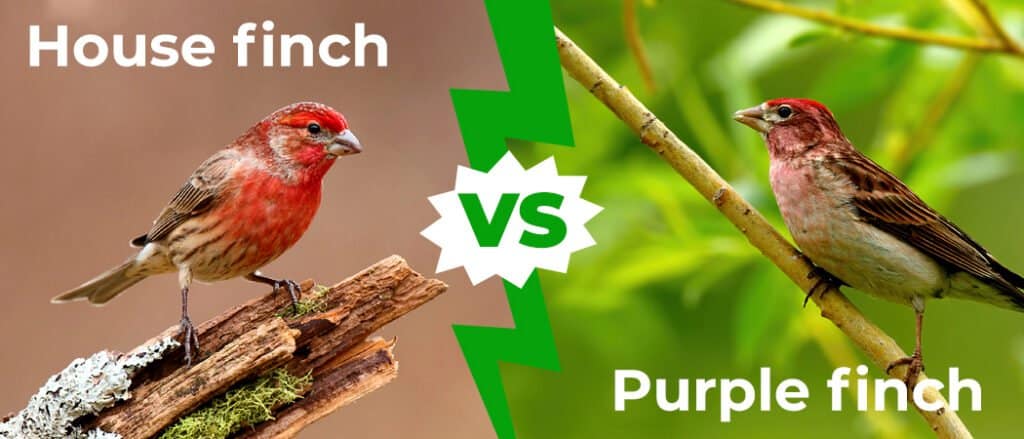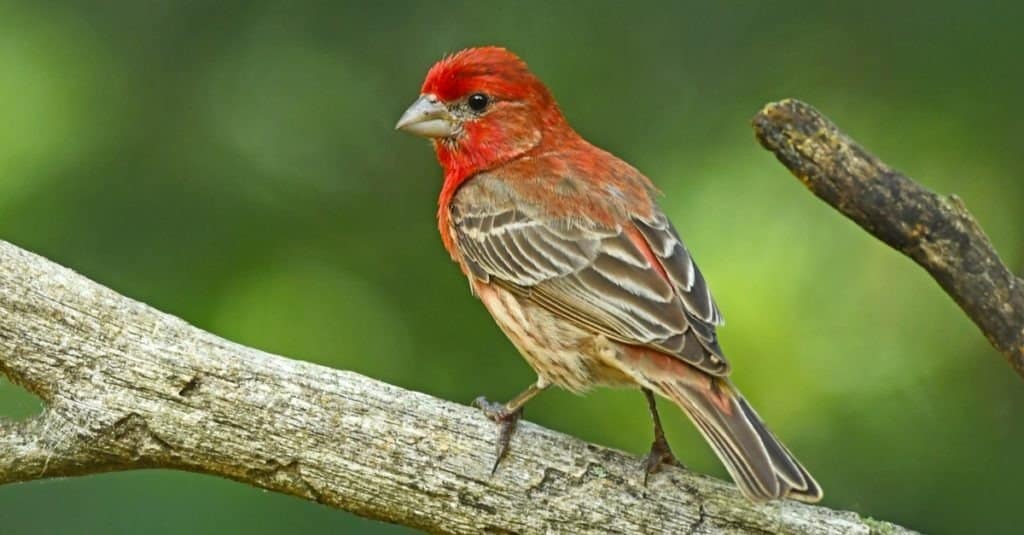House finches and purple finches are both small birds which are native to North America. Both species have stunning red and brown plumage which means that they are easily confused for each other. Although it might seem like their names differentiate them, but they don’t. Purple finches aren’t purple and house finches are always found near houses. But don’t worry as there are a few key differences which make them easy to tell apart once you know what you’re looking for.
For a start, they have very different behavior and one spends all of it’s time in a flock while the other doesn’t. There are also some distinctive differences in their color patterns, as well as the shape of their beaks and tails. But that’s not all, as there’s much more to learn about these beautiful finches. So join us as we discover all of the differences between a house finch vs a purple finch.
Comparing House Finch vs Purple Finch

House finches and purple finches are both favorites amongst people with bird feeders in their backyards, and telling the two apart can be quite tricky. Although house finches and purple finches are both characterized by their bright red plumage, there are some distinctive markings which make them easier to tell apart. If you get the chance to observe both species, then there are actually several noticeable differences between the two.
Check out the chart below to learn a few of the main differences between house finch vs purple finch.
| Purple Finch | House Finch | |
| Location | Canada and north east US | Native to western North America, introduced to eastern US and Hawaii |
| Habitat | Coniferous and mixed forests | Urban and suburban areas, deserts, grasslands, stream sides, coniferous forests |
| Wingspan | 10 inches | 9.5 inches |
| Color | Male – dark red with brownish wings Female – Brown with white streaks | Male – red breast, brown back with lighter streaks blurring the two colors Female – grayish brown, blurred streaks on underside |
| Head | Male – red head Female – distinctive white mark above eyes | Male – gray cheeks, red forehead and throat Female – Plain head, no distinctive markings |
| Tail | Short with a deep notch | Long with a slight notch |
| Bill | Large, not curved | Small with curved upper mandible |
| Body Shape | Stocky body | Smaller and thinner than purple finch |
| Behavior | Territorial and solitary | Social and not territorial |
| Flocks | Only during the winter | Live in flocks year round |
| Eggs | Rounded shape, no spots | Pointed end and speckled appearance |
| Diet | Seeds, berries, insects | Grain, seeds, berries, small insects |
| Predators | Adults – barn owls, merlins, kestrels, blue jays, cats Eggs & chicks – squirrels, grackles, jays | Adults – cats, Cooper’s hawks Eggs & chicks – blue jays, crows, raccoons, rats, skunks, snakes |
The 5 Key Differences Between House Finches and Purple Finches
House Finch vs Purple Finch: Size

Purple finches are stockier and larger than house finches
©Steve Byland/Shutterstock.com
One of the differences between house finches and purple finches is size. Purple finches are slightly larger than house finches and have a wingspan of up to 10 inches. Their bodies are stocky and they generally have a larger head and neck in proportion to their bodies. Purple finches are 4.5 to 6.3 inches long, while their weight ranges between 0.6 and 1.1 ounces.
House finches are slightly smaller and have a wingspan of up to 9.5 inches. Their bodies are smaller and thinner than purple finches. House finches are 5 to 6 inches long and weigh between 0.5 and 0.95 ounces.
House Finch vs Purple Finch: Habitat
Although their range does overlap, generally, house finches and purple finches prefer different habitats. House finches live in urban and suburban areas as well as deserts, coniferous forests, grasslands, and stream sides.
Purple finches prefer areas that are less populated, so they are far less likely to be found in urban areas compared to house finches. Purple finches generally live in coniferous and mixed forests. However, in areas where their range overlaps with house finches, purple finches lose out around 90% of the time to them. Their population has actually declined sharply in the east due to this competition.
House Finch vs Purple Finch: Bill
Although both house finches and purple finches are predominantly herbivorous seed eaters, they actually have quite different bills. House finches have a small bill with a distinctive curve on the upper mandible which gives it a bulbous shape, while purple finches have a much longer and straighter bill. As it doesn’t have a curve on the upper section, it appears to be a more triangular shape.
House Finch vs Purple Finch: Color
You’d easily be forgiven for thinking that purple finches are purple in color, but they’re actually not. Instead, males are dark red throughout with a red head and brownish wings, while females are brown with white streaks throughout their body. However, it is their face which is most distinctive as they have noticeable white marks above their eyes.
Male house finches also have red plumage but it is mainly confined to their breast, forehead, and throat. Throughout the rest of their body, they have a brown back with lighter streaks which blur the two colors. They also have grey cheeks. Female house finches are grayish brown with blurred streaks on their underside. Their head is plain and has no distinctive markings.
House Finch vs Purple Finch: Behavior

House finches are very social and live in flocks of several hundred birds all year round.
©Brian A Wolf/Shutterstock.com
Purple finches and house finches also have vast different behavior. House finches are social birds and are not territorial. They almost always are found in flocks which can range from a few birds up to several hundred. House finches even stick together when nesting too as the flock tends to nest close together. However, within these flocks, house finches exhibit hierarchical behavior with the females being dominant over the males.
In a complete contrast to house finches, purple finches are are only found in flocks during the winter and are territorial and solitary throughout the rest of the year. During the winter, they can be found in flocks of up to 200 birds consisting of not just purple finches, but several other finch species too. However, once breeding season comes around they become extremely territorial. Therefore, purple finches are usually alone or in a pair for the rest of the year.
FAQ’s (Frequently Asked Questions)
Are house finches and purple finches from the same family group?
Yes, both house and purple finches are from the family group Fringillidae which are true finches. They are also from the same genus – Haemorhous – which is the American rosefinches. As the name suggests, American rosefinches are characterized by their red plumage and are found across North America. The only members of this genus are house finches, purple finches, and Cassin’s finches.
Do house finches and purple finches migrate?
Purple finches are migratory birds and travel during the winter, which is when they live in large flocks. House finches are a bit different as only some of them migrate. Migration depends on where they live – house finches in the east don’t migrate, but house finches in the west migrate south during the winter.
Are house finches and purple finches considered to be endangered?
No, both species are not under threat and are considered to be “least concern”.
Bonus: How to Attract Finches to Your Home

Finches are delightful songbirds that are fun to watch.
©Aaron J Hill/Shutterstock.com
Finches of all types are a delight to see and hear whenever they visit your yard or garden. While bird experts don’t always recommend feeding wild birds – there’s no question that it provides pleasure for both the human and the birds! Here are some ways that you can attract these lively little birds to your home:
- Place your feeders where finches feel safe. The best spot is near a tree or shrub during the introduction period – but you can move it far enough away that squirrels can’t jump to it after the finches have claimed it.
- Fill the new feeder halfway. It may seem odd, but for some reason, a new half-full feeder seems to be more attractive to birds.
- Provide fresh black seed. Finches won’t feed on old-looking brown seed. Press on the seed with your fingernail – if oil comes out – your finches are sure to love it! Thistle seed can be stored in the freezer until you use it to preserve freshness.
- Add brightly colored ribbons or plants. Birds are attracted to bright colors and ribbons blowing in the wind make them believe that another bird has already tested and approved the feeder.
- Keep your finch feeder clean. Finches don’t like dirty feeders – especially clumped food that has gotten wet after it rains.
- Plant seed-bearing plants. Flowers in bloom and seed-bearing plants like sunflowers and pinecones attract birds.
- Provide black oil sunflower seed. Finches love the high-fat content! While it won’t fit into a thistle feeder – another feeder with this offering will attract all types of birds along with the finches.
The photo featured at the top of this post is © Real Window Creative/Shutterstock.com
Thank you for reading! Have some feedback for us? Contact the AZ Animals editorial team.






